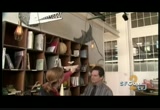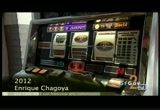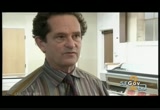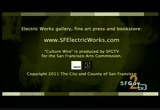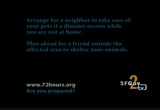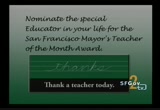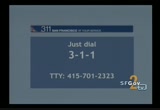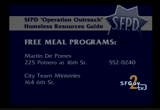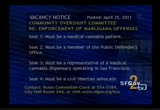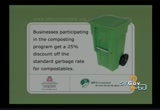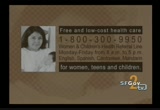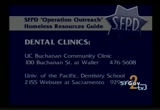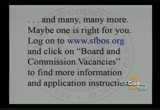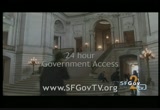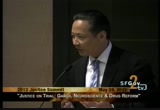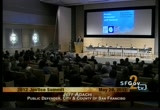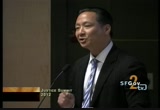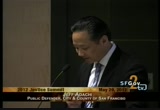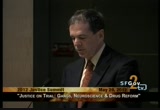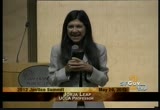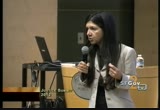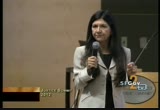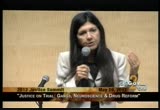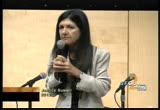tv [untitled] October 9, 2012 12:00am-12:30am PDT
12:00 am
have a whale head and various animals and their health over there, and they are jewelry. >> we do fund raisers for nonprofits, so we are doing a project for the magic theater, so there are some pretty funny cartoons. they are probably not for prime time. >> you sort of have a kind of holistic relationship where you might do merchandise in the store that promotes their work and practice, and also, prince for them. maybe we should go back and look at the print operation now. >> let's go. >> before we go into the print shop, i noticed some incredible items you have talked back here. what are we standing in front of? >> this is william wiley, only one earth.
12:01 am
this is a print edition. there are only eight total, and what we wanted to do was expand the idea of printmaking. this is really an art object. there we go. >> besides the punball machine, what do you produce in limited edition? >> there is the slot machine. if you win the super jackpot, you have saved the world. >> what about work? >> the right design, it was three volumes with lithographs in each volume. the cab of count dracula with 20 lithographs inside and lined with beaver fur. really special. >> let's move on to the print shop.
12:02 am
>> ok. the core of what we do is making things. this is an example. this is a print project that will be a fund-raiser for the contemporary music players. we decided to put it in the portfolio so you could either frame at or have it on your bookshelf. >> so nonprofits can come to you, not just visual are nonprofits, but just nonprofits can come to you, and you will produce prints for them to sell, and the profits, they can keep. >> the return on investment is usually four times to 10 times the amount of investment. this is for the bio reserve in mexico, and this is one of the artists we represent. >> you also make prints for the artists that you represent. over here are some large prints by a phenomenal artist. >> he writes these beautiful things. anyone who has told you paradise
12:03 am
is a book of rules is -- has only appeared through the windows. this is from all over coffee. we are contract printers for all kinds of organizations all across the country. >> thank you very much for showing us around today. i really appreciate you taking the time to let me get better acquainted with the operation and also to share with our "culturewire" team.
12:15 am
12:16 am
to increased consciousness and awareness of the issues that affect public safety in criminal and juvenile justice reform. i am proud to say that this is the ninth summit. we take on issues like closing the california youth authority. and we in the confinement of youth -- young children in -- and the prisoner re-entry program and abolishing the death penalty. we take on three critical issues. the first panel has a riveting discussion about gangs. and reducing gang violence. on our panel are former gang members, gang intervention
12:17 am
workers, police, public defenders, and researchers. we talk about strategies to reduce gang violence. i will introduce the keynote speaker in a moment. the second panel is a cutting edge -- cutting edge discussion about the relationship between the human brain and criminal behavior. we have top experts from all parts of the country to talk about what the brain research shows. that is the key to understanding how human beings behave, and why they may commit acts of violence. the afternoon's panel will have a debate about a proposed law that would reduce felony drug possession crimes to a misdemeanor.
12:18 am
this is what 13 states have done. we not only bring these issues to the forefront, but have the opportunity to participate -- and we have cards that you could fill out and questions. this promises to be a year of reform and change like we have never seen, and we now see prisoner reentry programs being implemented. we're still spending too much money and resources and not enough on rehabilitation and reentry. this november, the voters will decide on limiting the three strikes law. issues and measures long overdue. it is clear there is much more that needs to be done. according to a study that was
12:19 am
published this month -- since 1989, 2000 people have been wrongfully incarcerated and they served collectively, 10,000 years. an average of 11 years person. i would like to thank the people who made this summit possible. memoranda -- amy devon -- many volunteers and all of our speakers and panelists. i would like to thank the co- sponsors, and the bar association of san francisco. i would like to thank them for their help and support. it is my pleasure to introduce the president elect of the bar
12:20 am
association of san francisco. they provide conflict attorneys to handle cases when a defender is not available. >> i am the president elect of the bar association. we're very proud to co-sponsor the justice of it. on behalf of the 8000 members, and all of those who -- dedicate their careers -- we are very fortunate to have his leadership with top-notch legal representation. for those who were charged each year who are innocent. an important part of the mission is providing equal access to
12:21 am
justice. this is shared by his office and all the public defenders. we're proud of the conflict panel that he described, and we also provide the top-notch representation in matters that his office cannot handle. we applaud you for what you do and for those of you who could not make it, thank you very much. this year's public defender simon will be an interesting day, full of cutting edge issues. gang violence and brain science and crime, these are issues at the forefront and deserve all of our attention. this is a greatat>> your going p with me because i liked to
12:22 am
wander around and see faces. you have learned more about me that a lot of people know. for the last 10 years i have been married to someone who was a deputy chief of the lapd and i now refer to him as being in recovery. at the same time, i have been working extensively with home with industries, and my brother said, if he had dreamed i would be married to a policeman and working with a priest, somebody would be lying. i have been working with gangs and been involved with gangs, trying to figure them out for 34 years. i began as a young social worker in south los angeles.
12:23 am
with gang infested housing projects that are now almost mythic, jordan downs and nickerson gardens, and i worked in these projects during what is referred to as the decade of death, when crack and unregulated gun availability laid waste to communities of color. in los angeles during the late 1980's and early 1990's, there were 1000 homicides per year in the city of los angeles, not the county, the city. now, we have between 203 hundred homicides per year. people talk about the gang problem having been addressed. i want to share with you, what i
12:24 am
experienced, what i have learned, i am not a typical academic. i will not quote statistics to you or talk about theories. i will talk with you about practicality. pragmatic approaches, and i will talk about reality. san francisco, like los angeles learned, will never saw or deal with its gang problems effectively unless there is true collaboration. i will talk to you about what this looks like and feels like. i will speak to you about the lessons that we have learned as law enforcement had to come off of the high perch, in los angeles, law enforcement
12:25 am
learned, to their great fortune, that collaboration is the answer. i am going to talk to you about some of the lessons that were learned. i can tell you first that the people -- we have learned lessons from have been gang members themselves my research is engaged with talking to those current, active gang members and former gang members. i work to collect their life histories. we have over 300 life histories. and still the stories do not stop. what did we learn about people in gangs? i recall early on, sitting down with someone whose gang name was smiley.
12:26 am
he is written about in my book. smiley was a young man of 19, when i first sat down with him at home when industries. one thing he said to me was -- why was no one there for me. why does no one speak to me and why did nobody tried to stop this. he was arrested when he was 16 years old. he was told to lie about his age and say he was 18, so they could be together in jail. and from there his story unfolded. different things were done with him. ultimately, spile -- smiley was helped, but his words haunted me. why did no one speak to me, and
12:27 am
why did no one tried to stop me. i began to listen to the stories of the gang members, and my research team at ucla discovered some startling truths. gang members to leave the gangs. they leave the gang for a variety of reasons. they all have a turning point, when they decide to leave. and it changes them. this would be something that any of you would logically imagine. for female gang members, and we did not see many of them on that video, but they are out there. they are not mothers, they are active gang members. female gang members, the turning point came at the birth of a child. for male gang members, the
12:28 am
picture is more complex. it may be, surprisingly, it may be because they got their second strike, and they're frightened of getting the third. it may be because of the birth of a child, usually a sign. the gang world has not caught up with post-feminist theory. with the story that a gang member named maniac told me, he decided to leave the rolling 60's after 20 years, after achieving status. he was in the back seat of a car, being driven by one of his underlings in the front seat. one of his fellow gang associates got in the back seat with him. the associate said to move over.
12:29 am
maniac did not want to move over. maniac did not want to move over. the associate shoved him over and 10 seconds later, a gun was shot and the bullet came into the car, pierced the associate to the neck and killed him instantly. maniac said, if he had not shoved me aside i would be dead. i am done. that was his turning point. call it a turning point, called the teachable moment. use whatever terminology that you want. that is where we need to be present. when i say we, i mean, we. at that turning point,
149 Views
IN COLLECTIONS
SFGTV2: San Francisco Government Television Television Archive
Television Archive  Television Archive News Search Service
Television Archive News Search Service 
Uploaded by TV Archive on

 Live Music Archive
Live Music Archive Librivox Free Audio
Librivox Free Audio Metropolitan Museum
Metropolitan Museum Cleveland Museum of Art
Cleveland Museum of Art Internet Arcade
Internet Arcade Console Living Room
Console Living Room Books to Borrow
Books to Borrow Open Library
Open Library TV News
TV News Understanding 9/11
Understanding 9/11